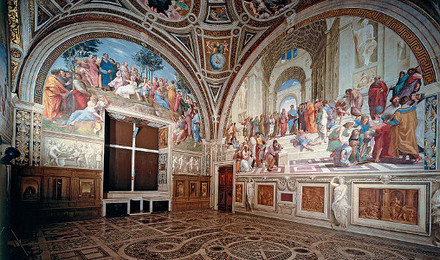Why Did Renaissance Artists Use Balance and Proportion in Their Art
 Raphael was one of three Main artists of the Renaissance
Raphael was one of three Main artists of the Renaissance
Raffaello Sanzio da Urbino, known as Raphael, was an Italian painter and builder of the High Renaissance and lived from 1483 to 1520. He is recognized equally 1 of the three great masters of that period, accompanied by Michelangelo and Leonardo da Vinci. His work is admired for its grade, composition, and visual accomplishment of the platonic of human grandeur.
Ane of his well-nigh famous works is The Schoolhouse of Athens, a fresco in the Apostolic Palace in the Vatican. Information technology captures the spirit of the Renaissance, and is revered as his masterpiece. It was painted between 1509 and 1511.
The School of Athens: Inspired by a union of art and mathematics
It was also in 1509 that Luca Pacioli published the book De Divina Proportione (The Divine Proportion), with illustrations by Leonardo da Vinci. MonaLisa.org reports that The Schoolhouse of Athens "incorporates many of the mathematical theories of Luca and Leonardo." "Civilisation" author Kenneth Clark is quoted there maxim "This spousal relationship of art and mathematics is far from our own way of thinking, but information technology was fundamental to the Renaissance."
Raphael made his utilize of the Gilt Ratio obvious
If there's any uncertainty that Raphael used the Aureate Ratio in this painting's limerick, information technology can exist eliminated with a skillful caste of conviction past the gilt rectangle that was placed front end and center in the painting. It'south as though Raphael made a minor simply undeniable argument to answer the question before it was asked. This small rectangle is near 18″ past 11.ane″ and is a rather unusual characteristic. Perhaps it once bore the championship or some description of the painting. Fifty-fifty the framed area immediately below it shows a framed that is in gilded ratio proportion to the borders on its sides. Click on the images for full resolution:
No other ratio would accomplish the same result in this composition
The painting has thousands of intricate lines, so some might say that finding gilt ratios inside it would be a elementary practice in pattern recognition. There are two means to overcome that objection. Y'all tin examination it for yourself past setting the Line Ratio in PhiMatrix (no cost trial) to any other ratio to see if you get the same affluence and consistency of results. Further, the gold ratios are very evident on the major elements of the composition alone. Note in the showtime image below (click to enlarge) that simple gilded ratios of the width and superlative of the painting ascertain the positions of the large wall of the outset arch, the summit of stairs at the floor and the top of the second arch. Other aureate ratios define other central elements of the limerick in the other images.
The intricate awarding of the gilt ratio is brilliant
To appreciate the intricacy and depth of Raphael's planning and awarding of the dimensional proportions in this painting, consider the illustration below. This image includes four rectangles that overlay the painting:
- Each rectangle begins at the left side of the left column in the painting. This betoken represents the beginning architectural reference betoken of the actual school building as viewed through the arched portal of the fresco.
- Each extends to a prominent composition feature on the right side of the painting.
- Each is divided into one or more golden ratios (accurate to the pixel with PhiMatrix software).
- Each dividing line illustrates a gilded ratio formed inside another prominent characteristic of the limerick.
Trace the 4 rectangles separately, each in its own colour, following it until you see the golden ratios that are revealed. Information technology may be easiest to wait showtime at the rectangles equally overlayed onto a blackness background, also shown below.
Raphael'south apply of the golden ratio is not but clear and compelling, merely quite brilliant in its execution. Do you agree? Your comments are welcome below.
References:
http://en.wikipedia.org/wiki/Raphael
http://en.wikipedia.org/wiki/The_School_of_Athens
Source: https://www.goldennumber.net/raphael-golden-ratio-in-renaissance-art/
 Raphael was one of three Main artists of the Renaissance
Raphael was one of three Main artists of the Renaissance
0 Response to "Why Did Renaissance Artists Use Balance and Proportion in Their Art"
Post a Comment